Indian
Cuisine 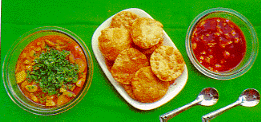
The food available in India is as diverse as
its culture, its racial structure, its geography
and its climate. The essence of good Indian
cooking revolves around the appropriate use of
aromatic spices. The skill lies in the subtle
blending of a variety of spices to enhance rather
than overwhelm the basic flavor of a particular
dish. These spices are also used as appetisers
and digestives.
Besides spices, the other main ingredients of
Indian cooking and Indian meals are milk products
like ghee (used as a cooking medium) and curd or dahi.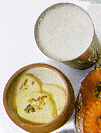 Lentils or dals
are also common across the country and regional
preferences and availability determine the actual
use in a particular area. Vegetables naturally
differ across regions and with seasons. The style
of cooking vegetables is dependent upon the main
dish or cereal with which they are served.
Whereas the Sarson ka saag (made with
mustard leaves) is a perfect complement for the Makke
ki Roti (maize bread) eaten in Punjab, the sambhar
(lentil) and rice of Tamil Nadu taste best eaten
with deep-fried vegetables. Lentils or dals
are also common across the country and regional
preferences and availability determine the actual
use in a particular area. Vegetables naturally
differ across regions and with seasons. The style
of cooking vegetables is dependent upon the main
dish or cereal with which they are served.
Whereas the Sarson ka saag (made with
mustard leaves) is a perfect complement for the Makke
ki Roti (maize bread) eaten in Punjab, the sambhar
(lentil) and rice of Tamil Nadu taste best eaten
with deep-fried vegetables.
Although a number of religions exist in India,
the two cultures that have influenced Indian
cooking and food habits are the Hindu and the
Muslim traditions. Each new wave of settlers
brought with them their own culinary practices.
However, over time they adopted a lot of
specialties and cooking methods from the Indian
cuisine and blended the two to perfection. The
Portuguese, the Persians and the British made
important contributions to the Indian culinary
scene. It was the British who started the
commercial cultivation of tea in
India.
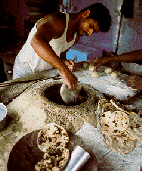
The Hindu vegetarian tradition is widespread
in India, although many Hindus eat meat now. The
Muslim tradition is most evident in the cooking
of meats. Mughlai food, kababs, rich
Kormas (curries) and nargisi koftas (meat-balls),
the biryani (a layered rice and meat
preparation), rogan josh, and preparations
from the clay oven or tandoor like
tandoori rotis and tandoori chicken
are all important contributions made by the
Muslim settlers in India.

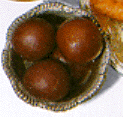 A
typical North-Indian meal would consist of chapatis
or rotis (unleavened bread baked on a
griddle) or parathas (unleavened bread
fried on a griddle), rice and an assortment of
accessories like dals, fried vegetables,
curries, curd, chutney, and pickles. For
dessert one could choose from the wide array of
sweetmeats from Bengal like rasagulla,
sandesh, rasamalai and gulab-jamuns.
North Indian desserts are very similar in taste
as they are derived from a milk pudding or rice
base and are usually soaked in syrup. Kheer a
form of rice pudding, shahi tukra or bread
pudding and kulfi, a nutty ice-cream are
other common northern desserts. A
typical North-Indian meal would consist of chapatis
or rotis (unleavened bread baked on a
griddle) or parathas (unleavened bread
fried on a griddle), rice and an assortment of
accessories like dals, fried vegetables,
curries, curd, chutney, and pickles. For
dessert one could choose from the wide array of
sweetmeats from Bengal like rasagulla,
sandesh, rasamalai and gulab-jamuns.
North Indian desserts are very similar in taste
as they are derived from a milk pudding or rice
base and are usually soaked in syrup. Kheer a
form of rice pudding, shahi tukra or bread
pudding and kulfi, a nutty ice-cream are
other common northern desserts.
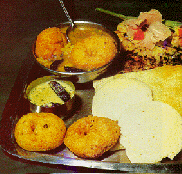
South Indian food is largely non-greasy,
roasted and steamed. Rice is the staple diet and
forms the basis of every meal. It is usually
served with sambhar, rasam (a thin soup),
dry and curried vegetables and a curd preparation
called pachadi. Coconut is an important
ingredient in all South Indian food. The South
Indian dosa (rice pancakes), idli (steamed
rice cakes) and vada, which
is made of fermented rice and dal, are now
popular throughout the country. The popular
dishes from Kerala are appams (a rice
pancake) and thick stews. Desserts from the south
include the Mysore pak and the creamy payasum.
A meal is rounded off with the after-dinner paan
or betel leaf which holds an assortment of
digestive spices like aniseed, cloves, arecanut,
and cardamom.

|